Wet Rendering Tallow for Skincare in a Crock Pot
Interested in making your own tallow-based skincare products? The first step is rendering your tallow so that it is completely purified with no beefy odor. The easiest method that we’ve found to do this is by wet rendering your tallow in a slow cooker. Don’t be intimidated. With this easy to follow step-by-step guide, you’ll be making your own balms, lotions, and soap in no time!
After first making the move to ditch processed food for real food about a decade ago, examining what we were putting on our skin was the next step. Within a few years, we’d swapped all of our conventional skin care products for things like tallow balm, shampoo bars, magnesium lotion, and mineral sun screen.
We quickly realized that purchasing the natural stuff was quite an investment. So slowly, one thing at a time, we began learning to make our own skincare products.
And the first step in the process is using this wet rendering method to have your own tallow ready to go!
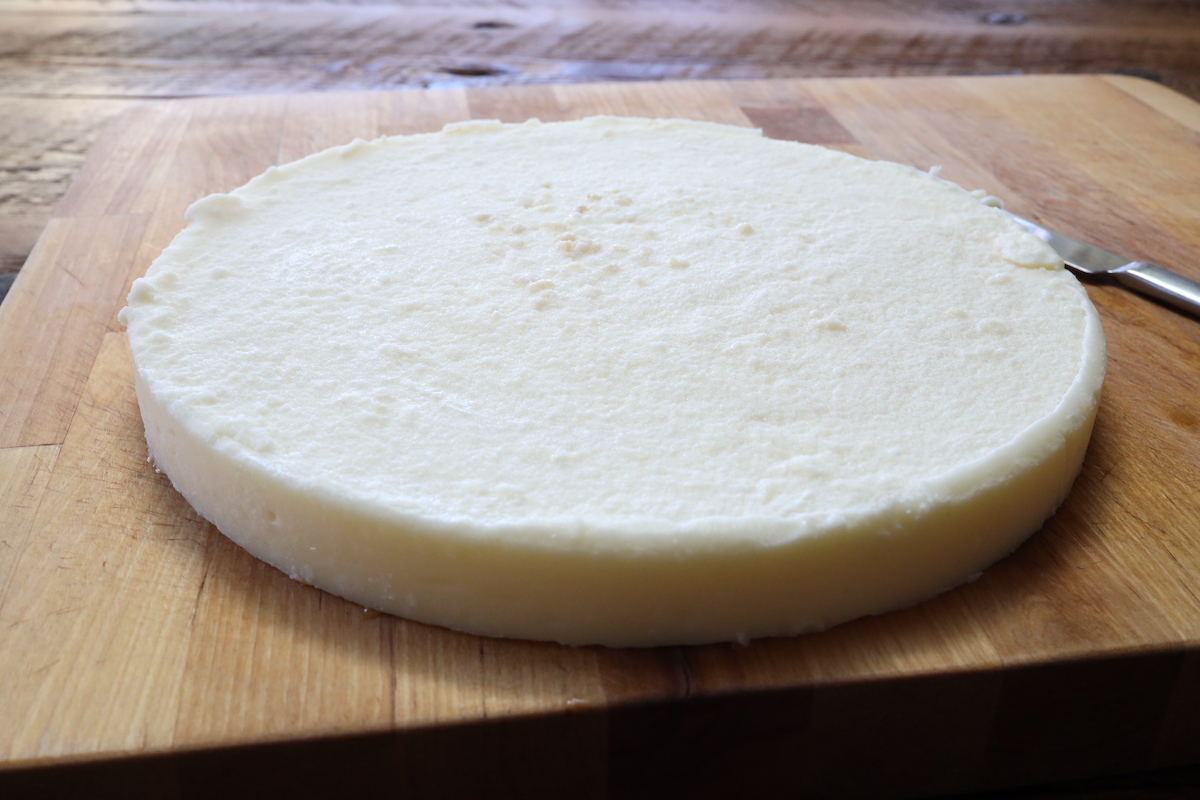
What is Tallow?
Simply put, tallow is rendered beef fat.
When a cow is processed you are left with the beef fat, AKA—suet. Suet is large, solid white chunks of fat pieces. The process of melting down that suet is called rendering and that’s how you get tallow.
Tallow forms a white solid at room temperature, melts into a clear liquid at around 90°F, and has a high smoke point for cooking. It is shelf stable for weeks or months, or it can be kept in the fridge or freezer for longer term storage.
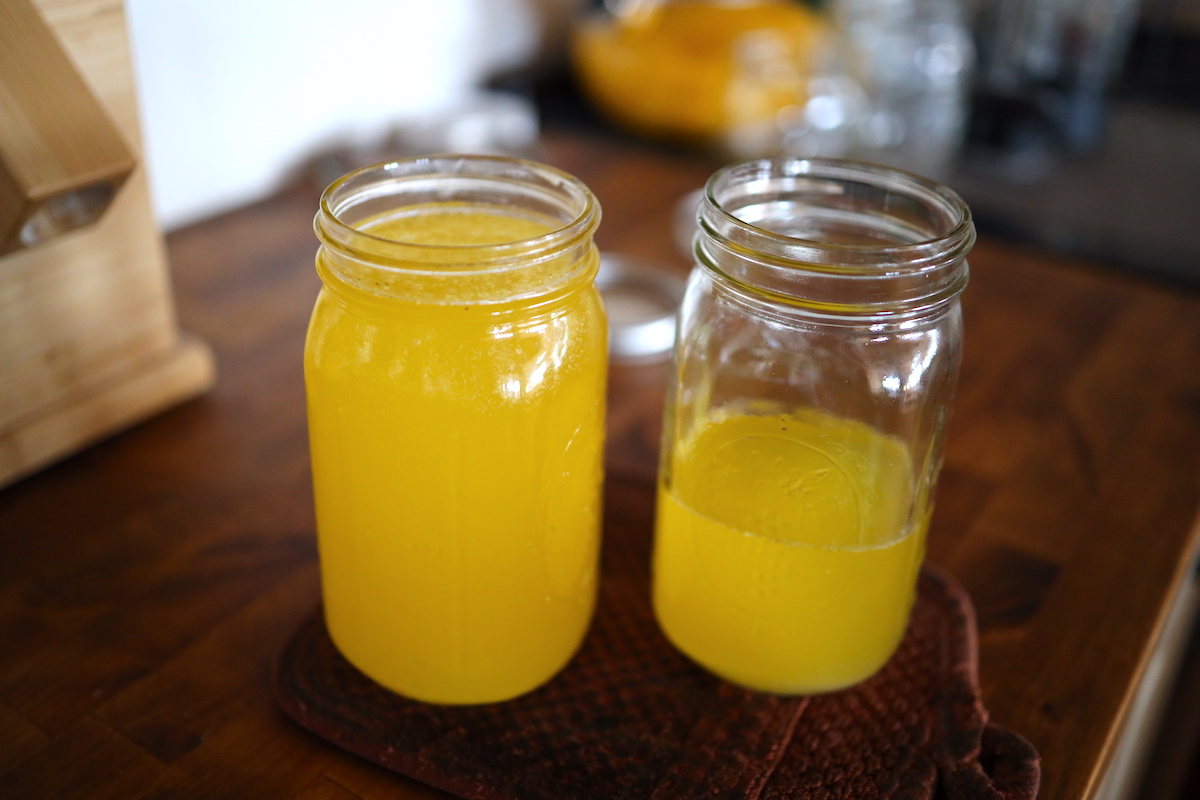
Why Tallow for Skincare?
For most of history, animal fats have been a main ingredient in skin care practices. In recent years, we swapped this natural moisturizer out for synthetically made chemicals, alcohols, etc.
Thankfully, the trend is moving back to the practices of our Great Grandma’s. Many are opting for incorporating natural fats, like tallow, back into skin care. And for good reason.
Tallow is highly compatible with skin. In fact, once I started implementing the use of tallow on my own skin, there was no going back. I had never experienced anything that moisturized so well and left my skin feeling so good.
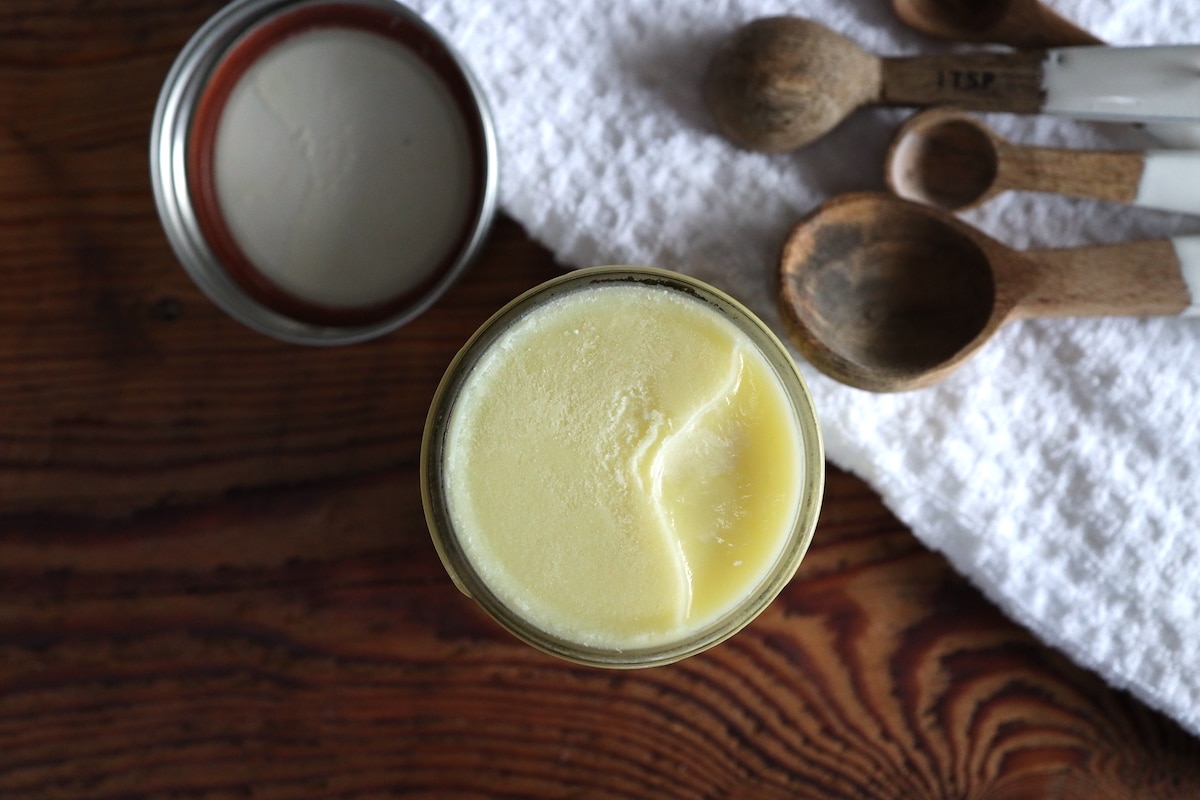
Other benefits of tallow:
- Tallow is rich in minerals as well as fat soluble vitamins A, D, E, and K, along with vitamin B12
- Contains conjugated linoleic acid (CLA) with natural anti-inflammatory properties
- Palmitoleic acid is a powerful antimicrobial agent that is also a basic building block of our skin
- Palmitic acid helps to improve the function of the skin’s protective barrier
- Stearic acid helps to repair damaged skin and improves the skins flexibility and suppleness
This list just begins to scratch the surface of the natural benefits tallow offers.
DRY vs. WET Rendering
As it sounds, the difference between the dry rendering method vs wet rendered tallow is whether or not water is added.
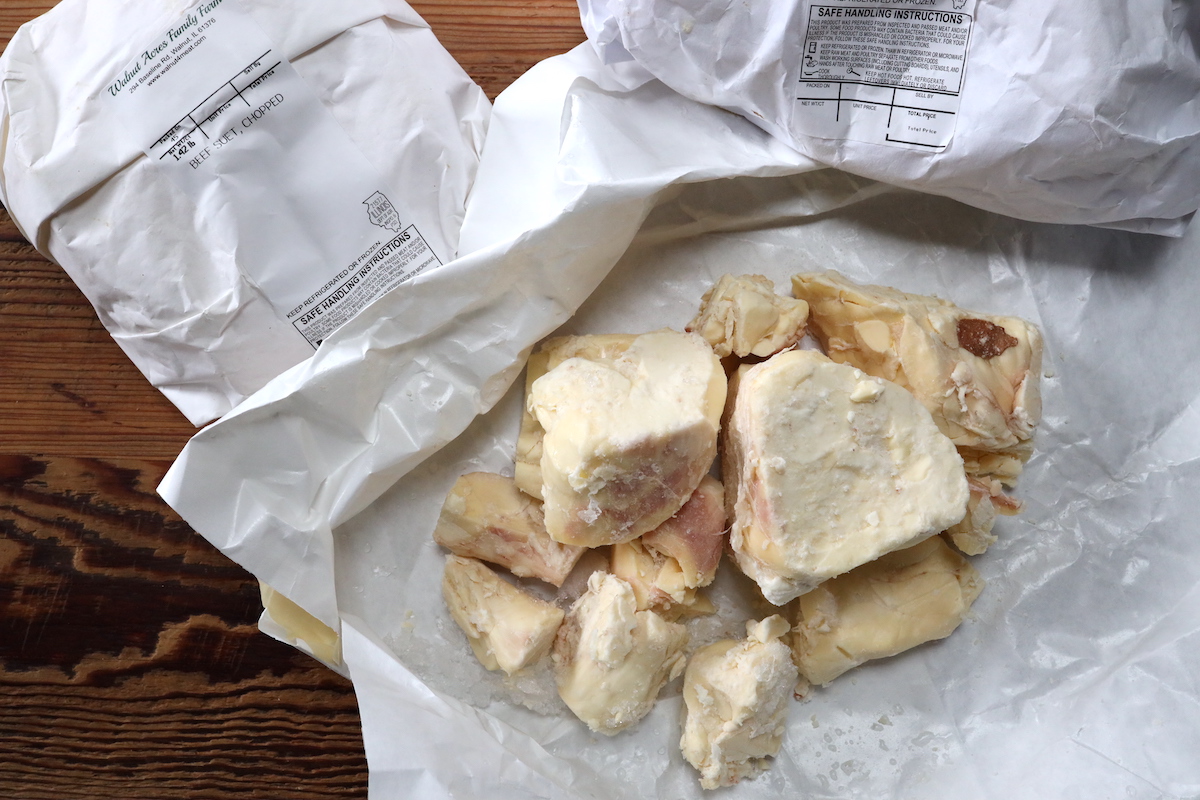
Dry-rendered tallow is done by chopping up fat into small pieces and melting it down directly over medium heat on the stove or in a crock pot. When it comes to cooking with animal fat, the dry method is the way to go in our opinion. You can find our step-by-step instructions for dry rendering here.
The downside to the dry method is that without the use of water, it can be easy for the fat to burn slightly and give a stronger odor. Dry rendering tallow is great for cooking a steak or frying up some french fries. But when it comes to skin care, no one wants to walk around smelling like beef.
The wet render method is the process of adding water and salt when melting down the suet into tallow. The water keeps it from burning and adding salt removes any impurities, giving you a rendered fat that is odorless, purified, and ideal for using on skin.
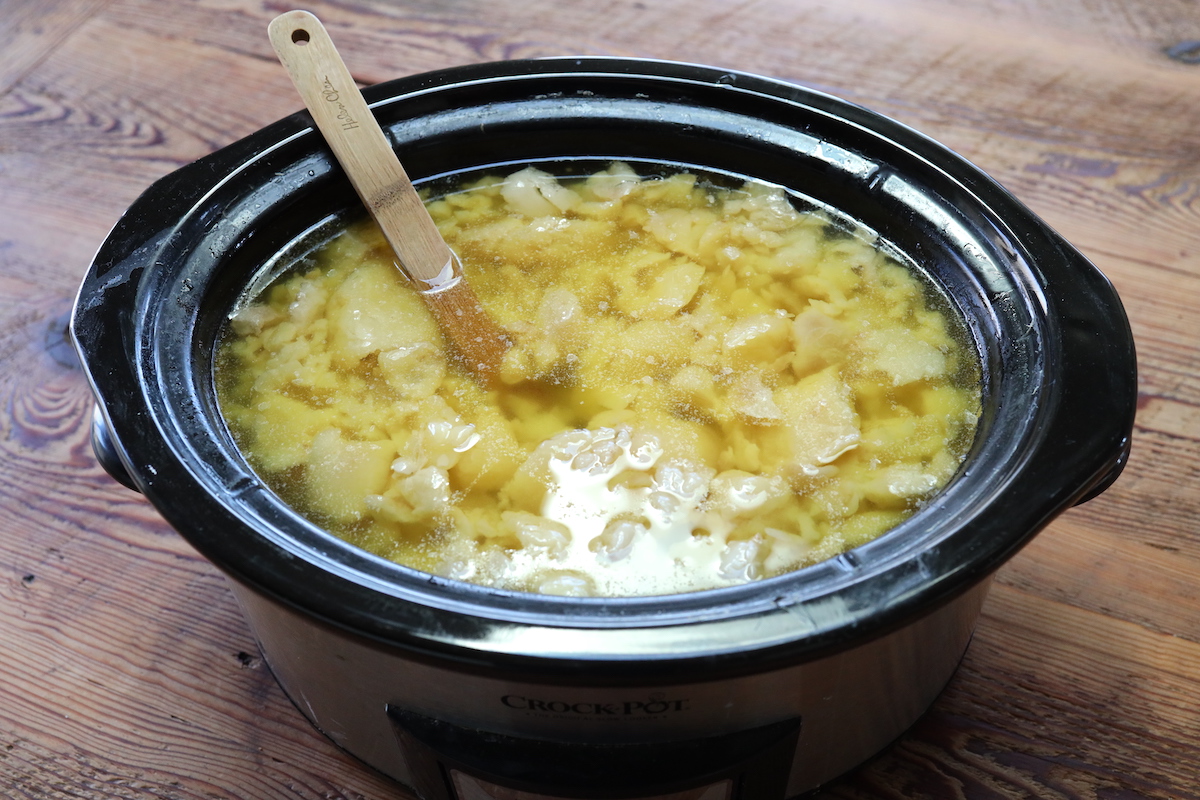
What do you need to render tallow using the wet method?
To successfully render your own beef suet into tallow, all you need are 3 simple ingredients:
Beef Fat – Suet.
Sea Salt – We like to buy Redmond’s Sea Salt in bulk because we go through so much of it.
Filtered Water – Avoid using chlorinated tap water to render your beef fat. Filtered or distilled water would be a better option.
Enjoy 15% off your Redmond order using code fromscratch.
How To Wet Render Tallow
Thankfully, the rendering process to make your own beef tallow is pretty basic. It does require several hours or even days of time, but none of the steps are hard.
First, gather your ingredients. I was able to fit around 5 – 5.5 pounds of fat into a standard 6-quart size crock pot.
Tip: It’s best if your fat is either ground up or shredded, or cut into small chunks. Your butcher should be able to do this for you if ask. Or you could shred it yourself using a food processor. Some of our fat pieces were large—it’s a good idea to cut the large chunks into smaller pieces to increase surface area and help you render the most tallow from your fat.
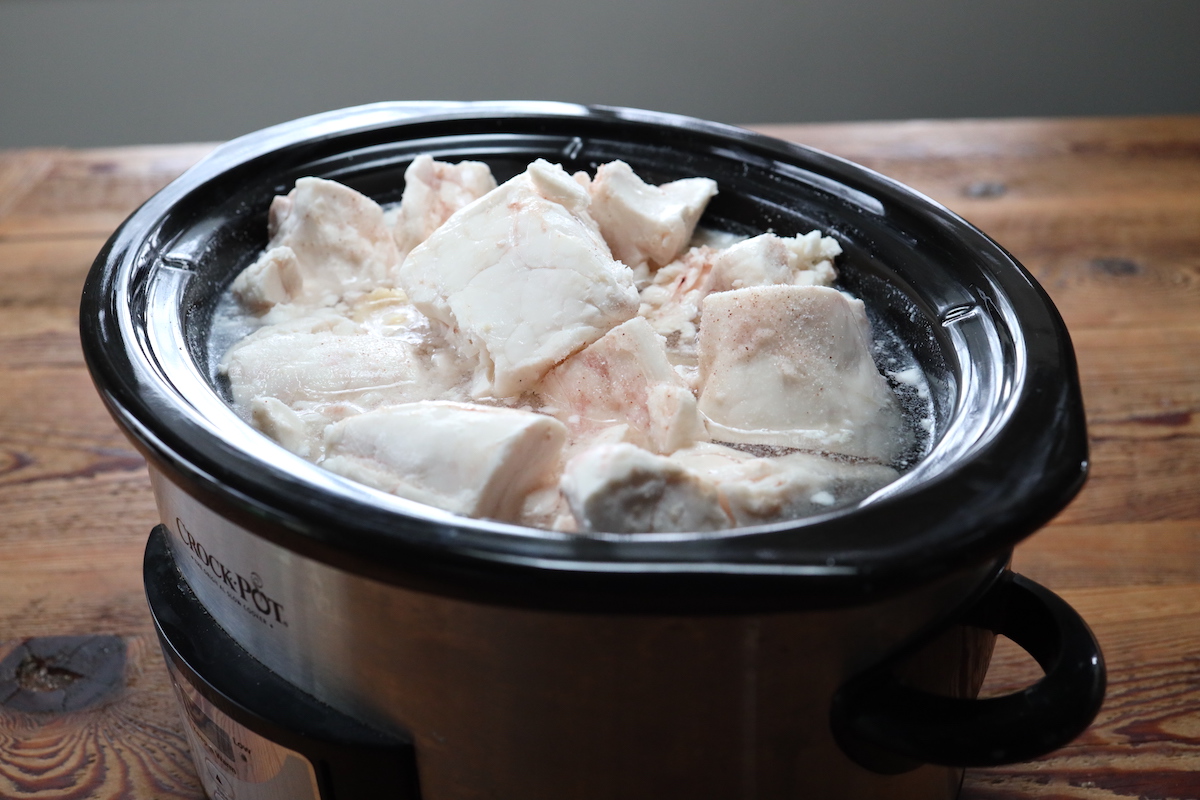
Place your fat into your crockpot along with roughly 6 cups of water and 3 tbsp of salt.
Turn your crock pot on low heat and let it do it’s thing for several hours, stirring occasionally. I like to get the process started before bed and let it slow cook all night.
After the fat has been cooking on low for a long time—at least 6-8 hours—turn the heat off.
Tip: Turning the heat off and letting the crockpot cool down before handling makes it much easier to work with when straining.
After the crockpot has cooled, it’s time to strain off any fat that’s left or even bits of meat that could be in there.
The best way we’ve found to do this is by using placing a strainer lined with cheesecloth inside our large stockpot. Another good setup would be to use a large metal bowl and a fine-mesh strainer lined with cheesecloth.
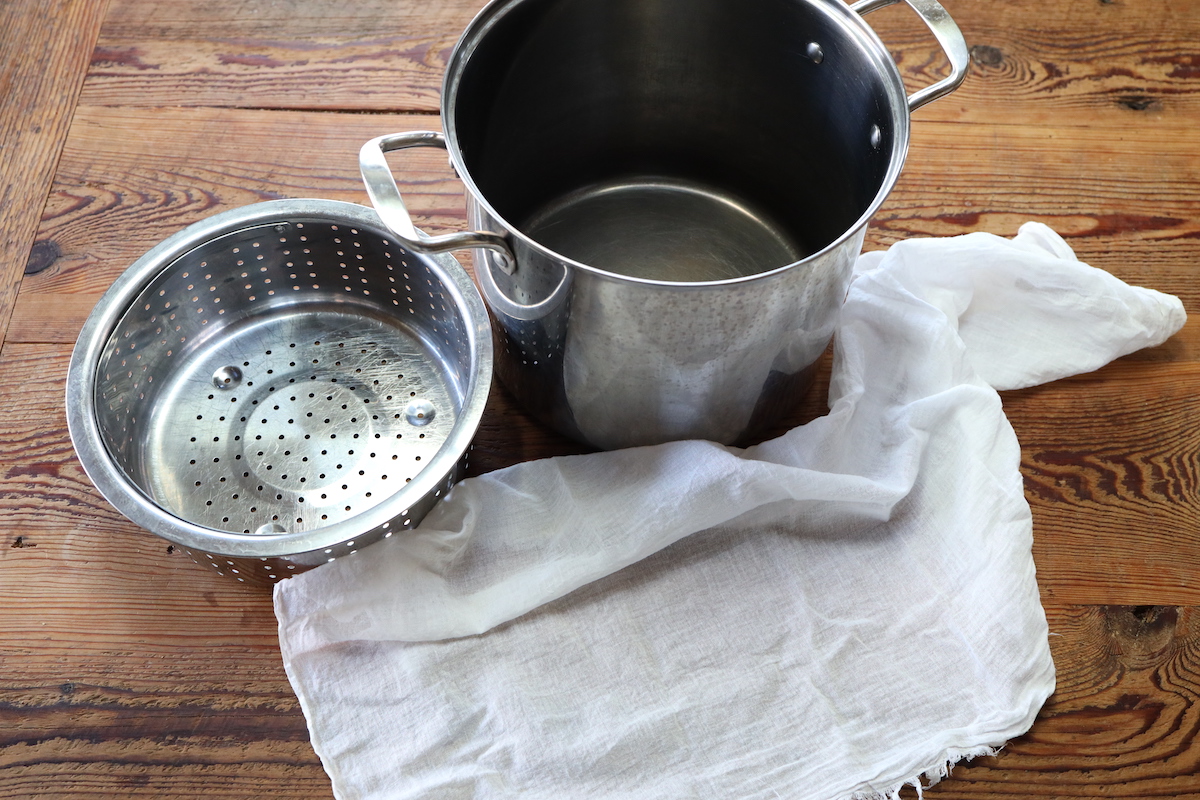
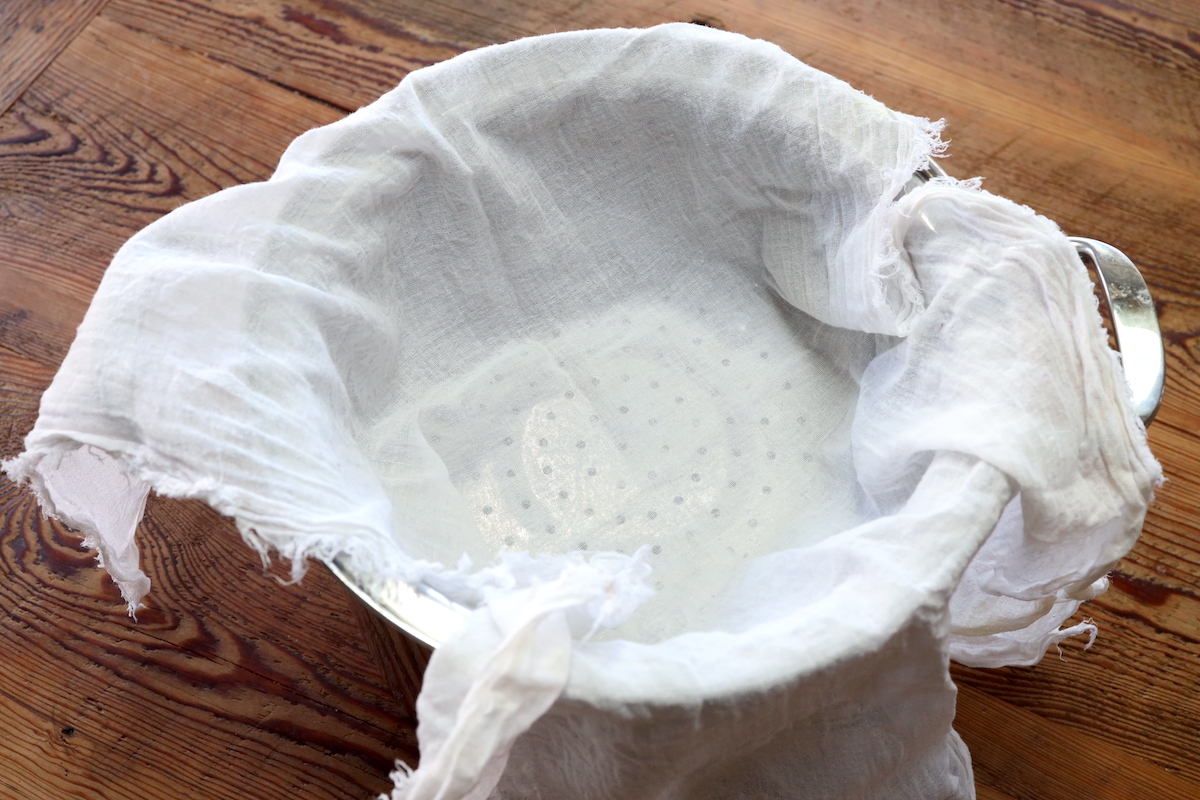
In the sink, I use a Pyrex measuring cup to scoop the melted fat and water from the crockpot into the strainer. You could pour the contents of the crockpot directly into the strainer. But I’ve found scooping out a few cups at a time is worth the extra steps for way less chance of a mess.
Once everything from your crock pot has been removed, gently squeeze the cheesecloth to extract any remaining melted fat.
Discard the bit of fat strained off after rendering.
Tip: We like to give the remaining fat pieces to our chickens. We just wouldn’t recommend making that fatty of a treat a regular practice.
Place the bowl or pot in the refrigerator for a couple of hours until the tallow becomes firm.
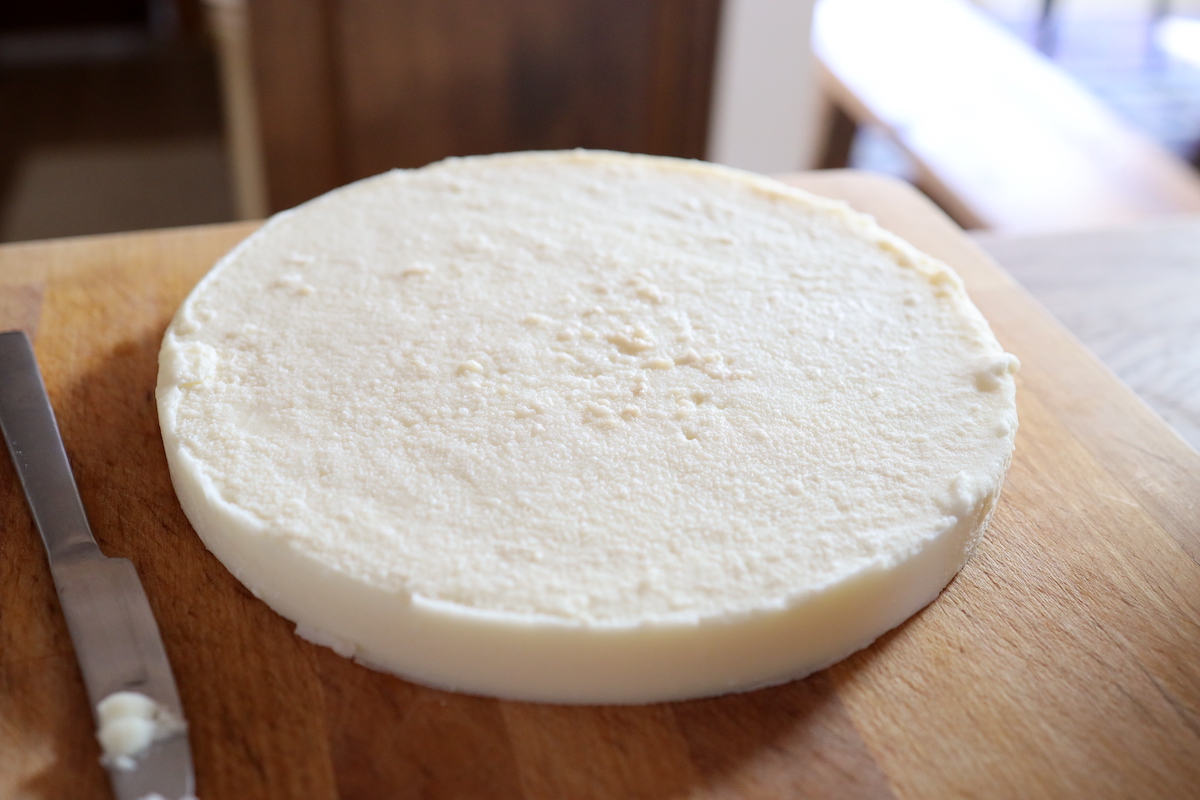
The easiest way we’ve found to remove the hardened tallow is by working the edges loose with a sharp knife and over the sink and pouring out the separated water. From there, you can work the tallow disk out of the pot or bowl.
The top side of your tallow disk will be smooth and flat while the other side will have more of a grainy texture and can be white or grayer in color, depending on the tallow you used. Flip the tallow over on a cutting board so that the grainy side is up. Carefully scrape that layer off of your disk of tallow until it is smooth.
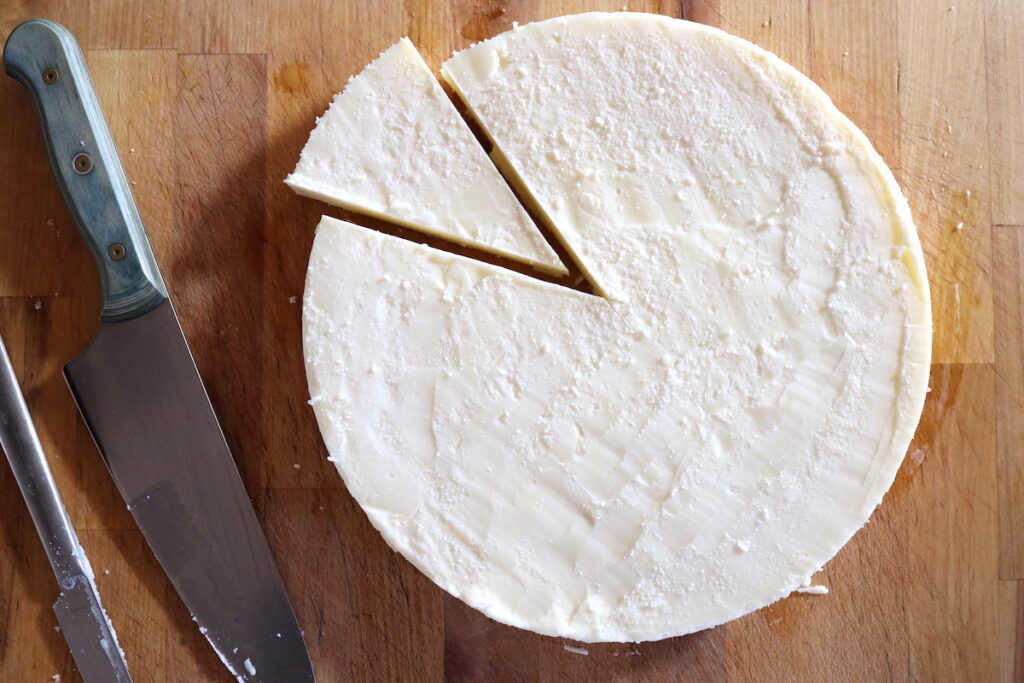
Repeat the entire purifying process.
Cut the tallow into smaller chunks and place back in your crockpot and add water. I don’t add as much water the second time, only about 4 cups, but enough water to prevent potential burning. Add another 2-3 tbsp of salt.
Heat for a couple of hours on low until the fat melts completely.
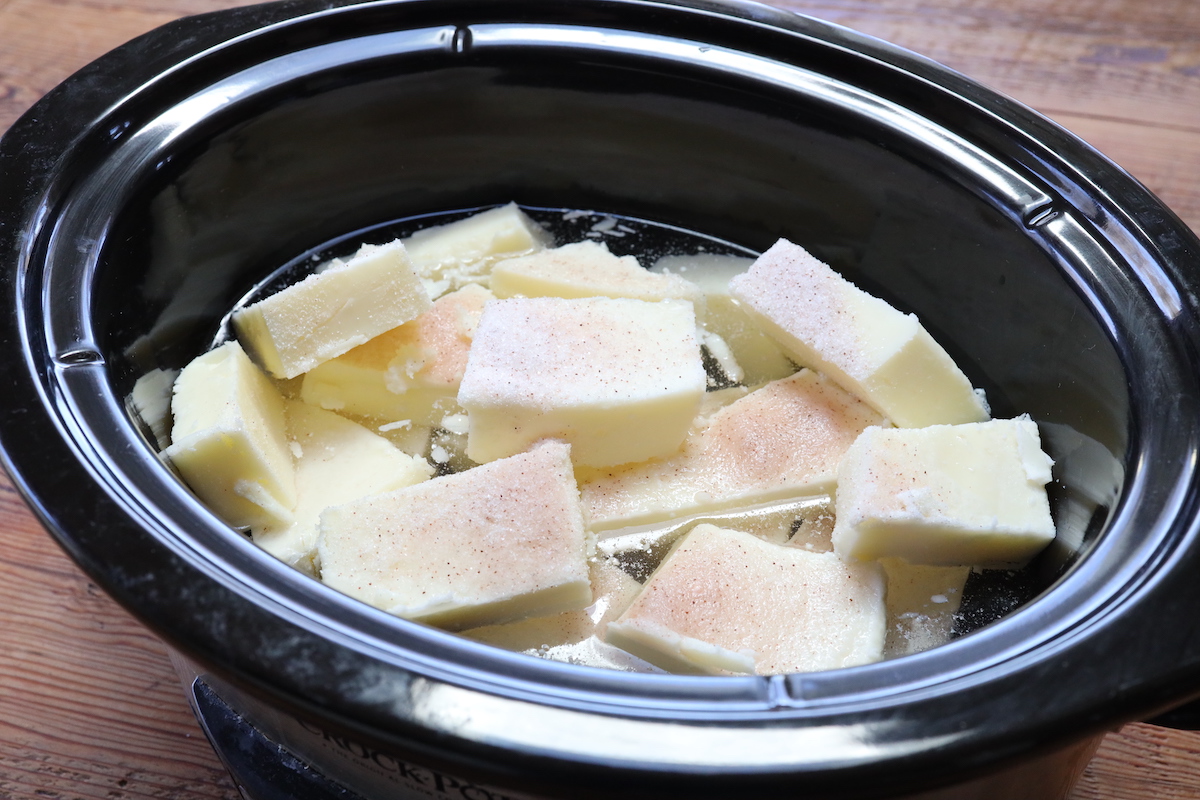
Turn off and let cool.
Strain your fat/water mixture.
Chill your bowl or pot in the fridge until tallow hardens.
Remove and scrape off any impurities on your disk of tallow.
You can repeat this process as many times as needed until you feel that you have a completely purified product. The finished tallow should be white with very minimal, to no, odor.
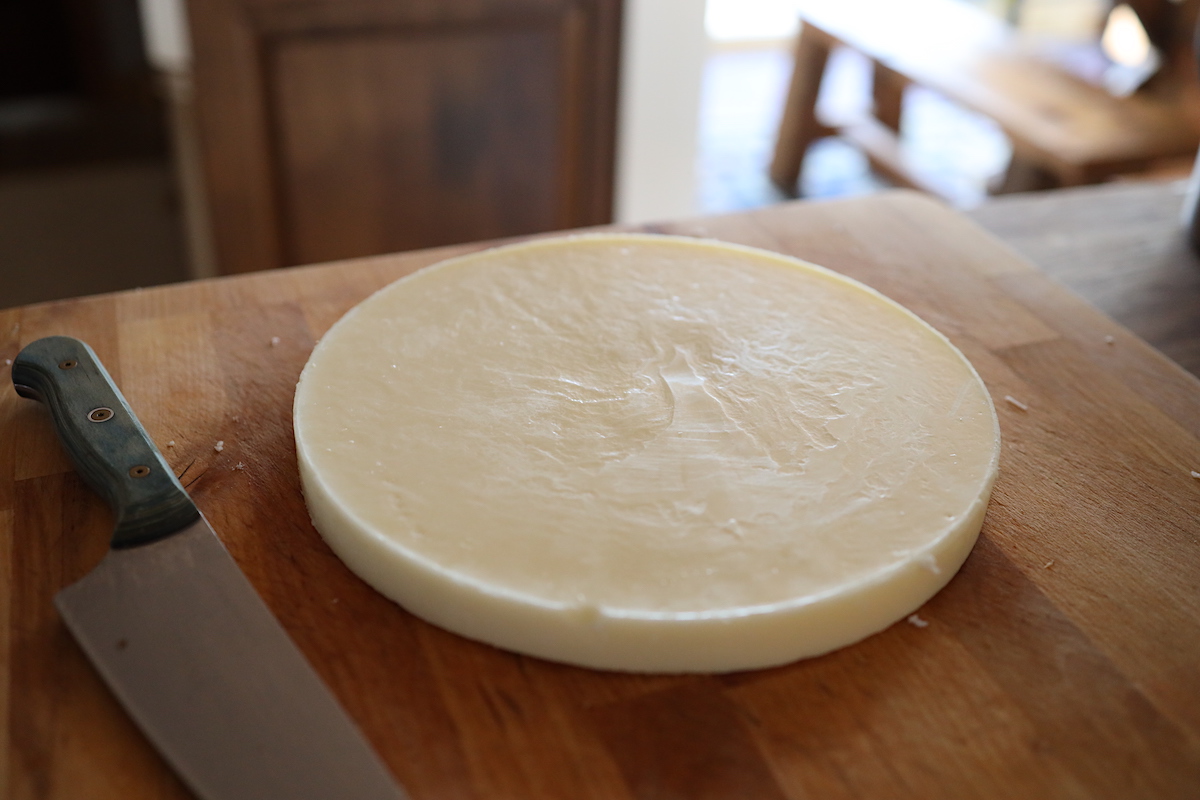
To store tallow, I melt it down over very low heat on the stove, watching carefully to make sure that it doesn’t burn. Then pour into mason jars or other glass storage containers for long term storage.
Frequently Asked Questions?
How to store tallow long term?
The purified tallow disk can simply be cut up and stored as large, hardened pieces. However, I find it easiest to melt the tallow down and then pour it into mason jars for long term storage.
The tallow is shelf stable at room temperature for a few weeks – months. But we like to store it in the fridge for longer term use.
It will store well in the fridge or freezer for months or even years.
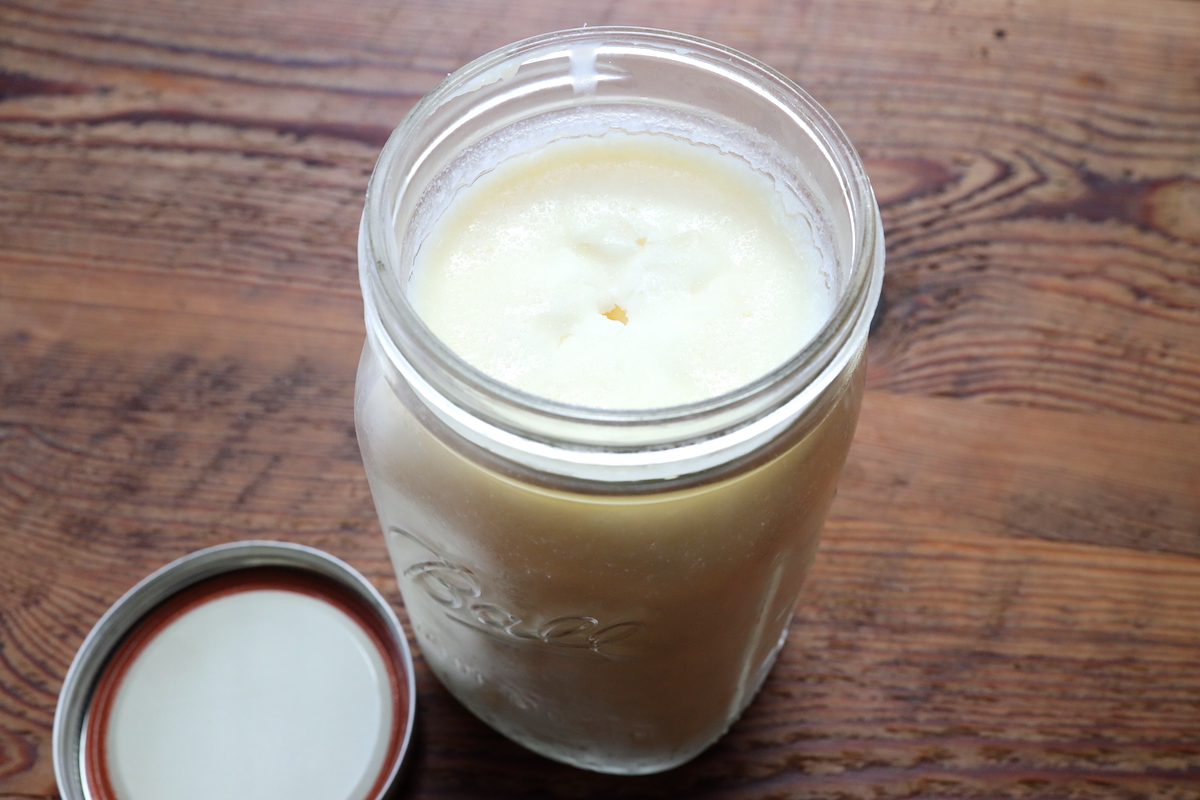
Does sourcing matter when it comes to tallow?
Our preference is to always look for grass-fed beef on farms that follow regenerative practices. This helps to ensure that the tallow you are getting is not only going to be the best for you in terms of quality and nutrients but this is also best for the health of the animal and the planet as well.
How to source high quality beef fat (suet) to render into tallow?
The two places I would start with are a local farm or butcher.
We’ve found that beef fat isn’t often flying off the shelves for many small, local farms and they are more than happy to sell the suet that they have collecting in their freezers. To find a local farm, ask around at farmer’s markets or check out the website localharvest.org.
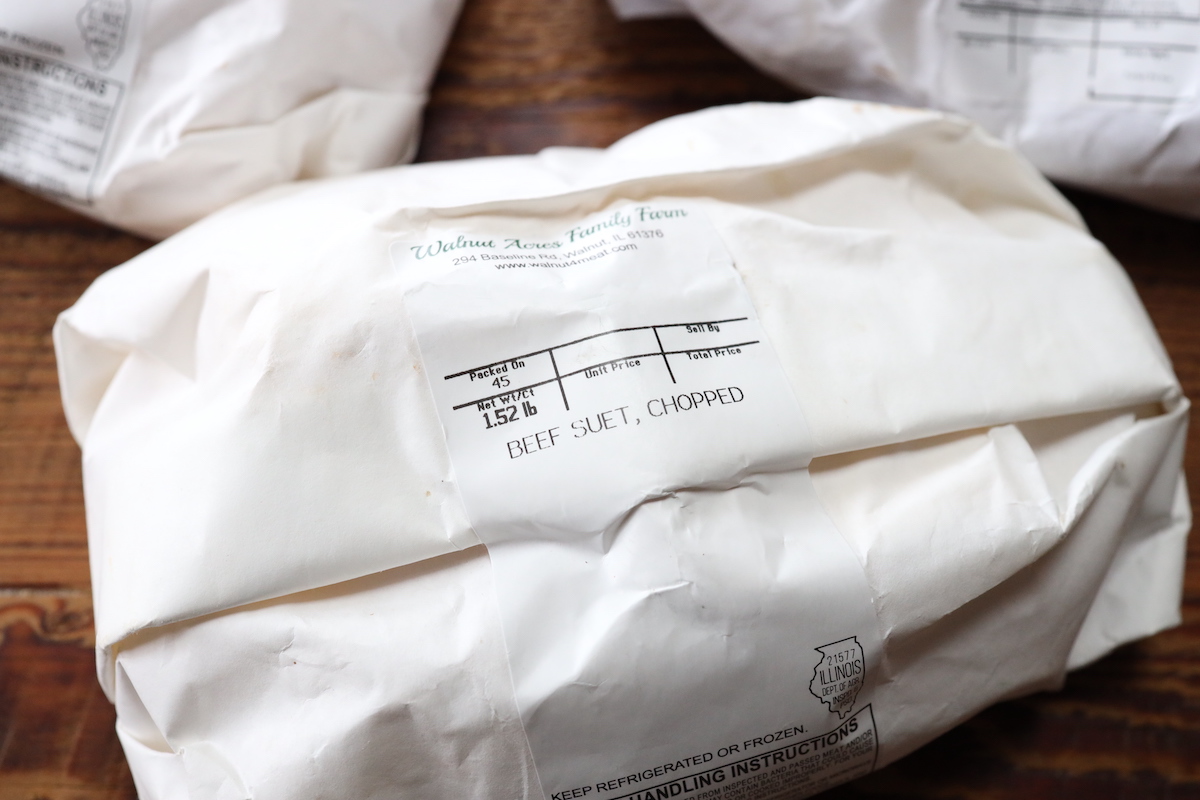
A local butcher is another great place to look. However, it can be harder to find the same quality of tallow at a butcher than going to a farm directly that is transparent about the practices they use.
Can I wet render tallow on the stove?
Yes! However, I’ve found the very even heat of the crockpot makes it much easier to not have to worry about the constant stirring and monitoring that is more necessary when cooking on the stove to make sure that it doesn’t burn.
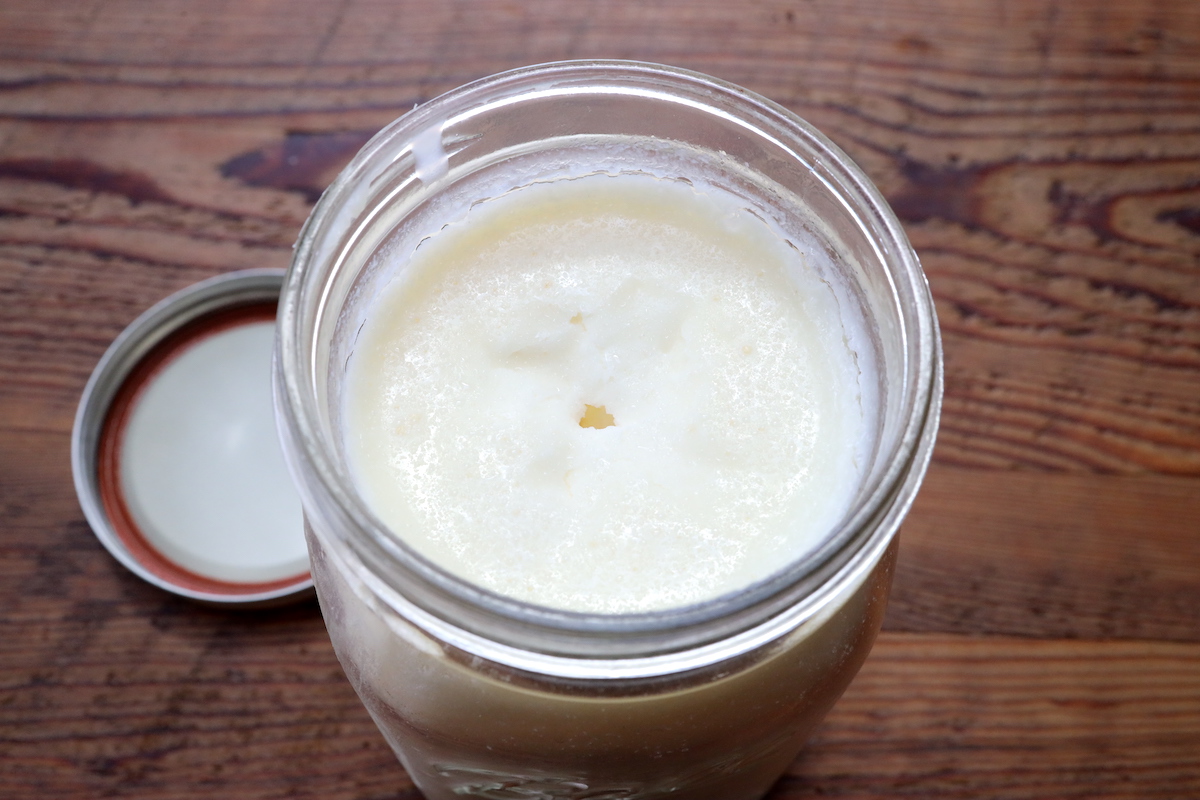
What about using other animal fats instead?
There can be great benefits to using the rendered fat from other animals as well for cooking or use in skin care. Rendered pork fat, called lard, is a great option. The rendered fat from deer, sheep, bear, and many other animals has been used throughout history!
Wet Rendered Tallow — Complete Step-By-Step Process
Note: I’m not adding specific amounts here because it will depend on how much you want to do/how big your crock pot is and how many times you render. See How To Wet Render Tallow section above for quantities I used as a reference.
Ingredients:
Beef suet, chopped small or shredded
Sea Salt
Water
Directions:
1. Place suet in a crockpot with roughly 6 cups of filtered water and 3 tbsp salt.
2. Cook on low for 6-8 hours, stirring occasionally. Let cool.
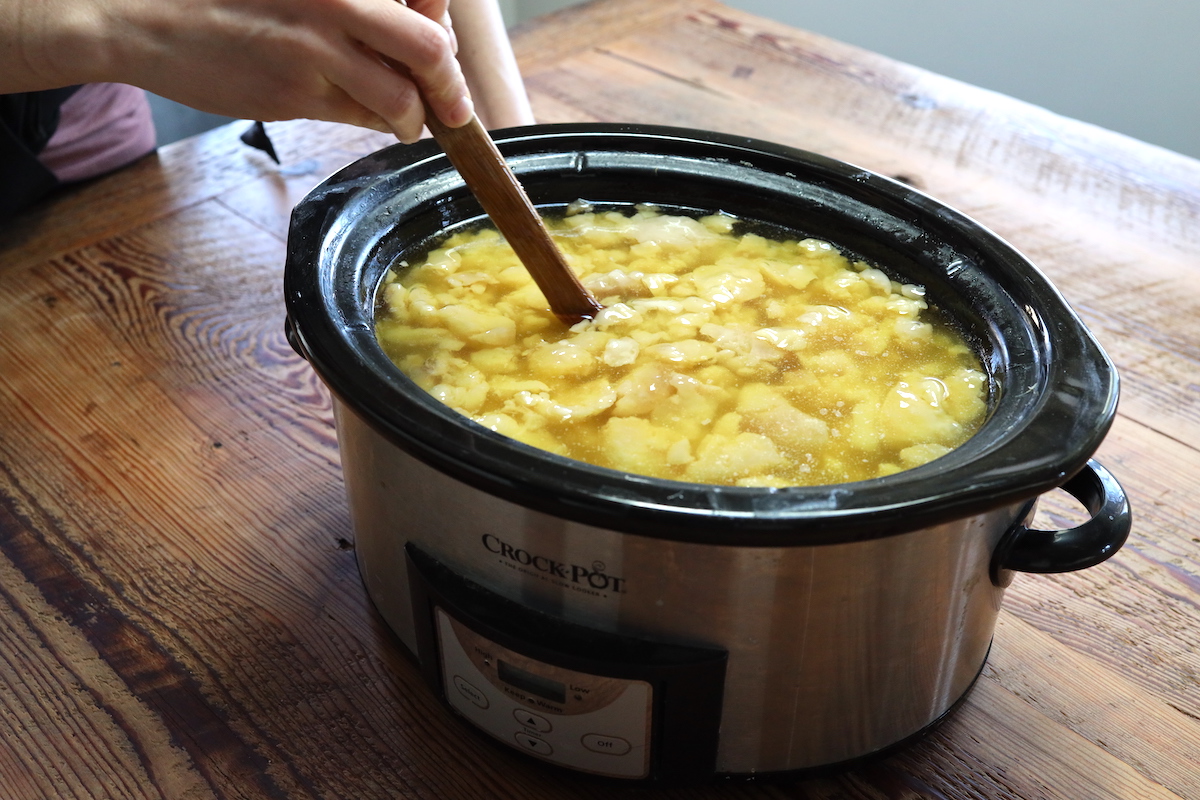
3. Strain by placing a fine mesh strainer lined with a cheesecloth over a bowl or stock pot. Carefully scoop out the contents of the crockpot and let run through the strainer.

4. Gently squeeze out any remaining melted fat from the solid pieces inside the cheesecloth.
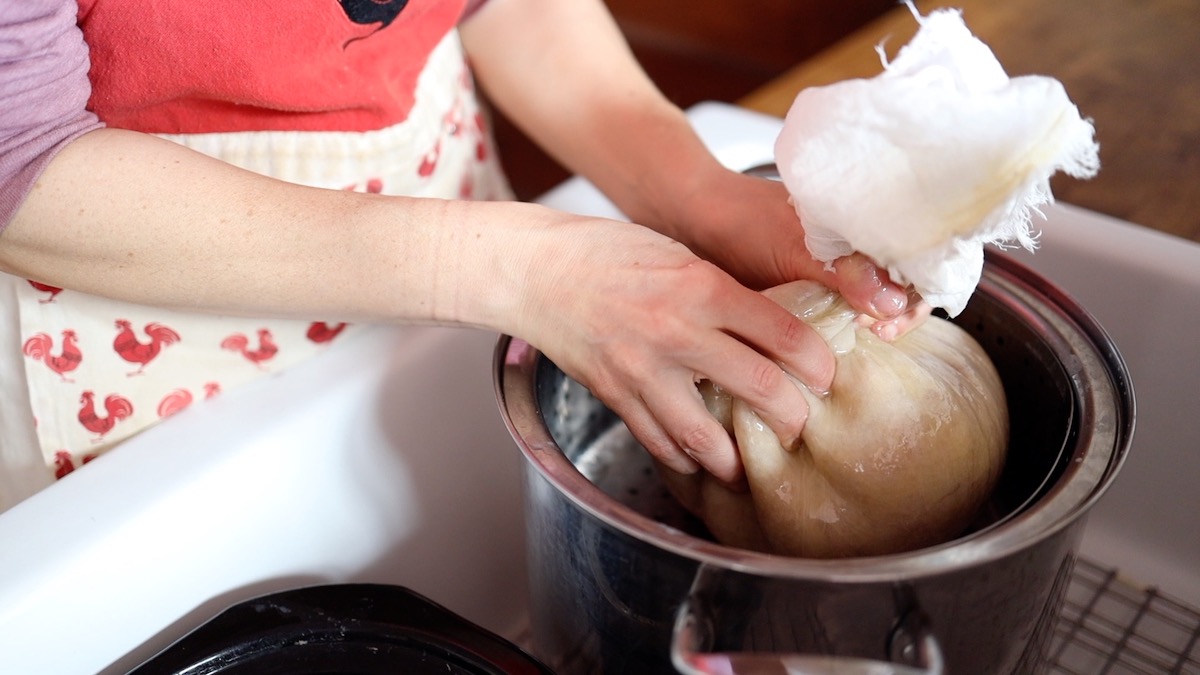
5. Place bowl in the fridge for 1-2 hours until tallow hardens.
6. Remove bowl and scrape along the edges of the tallow to release and pour the separated water in the sink.
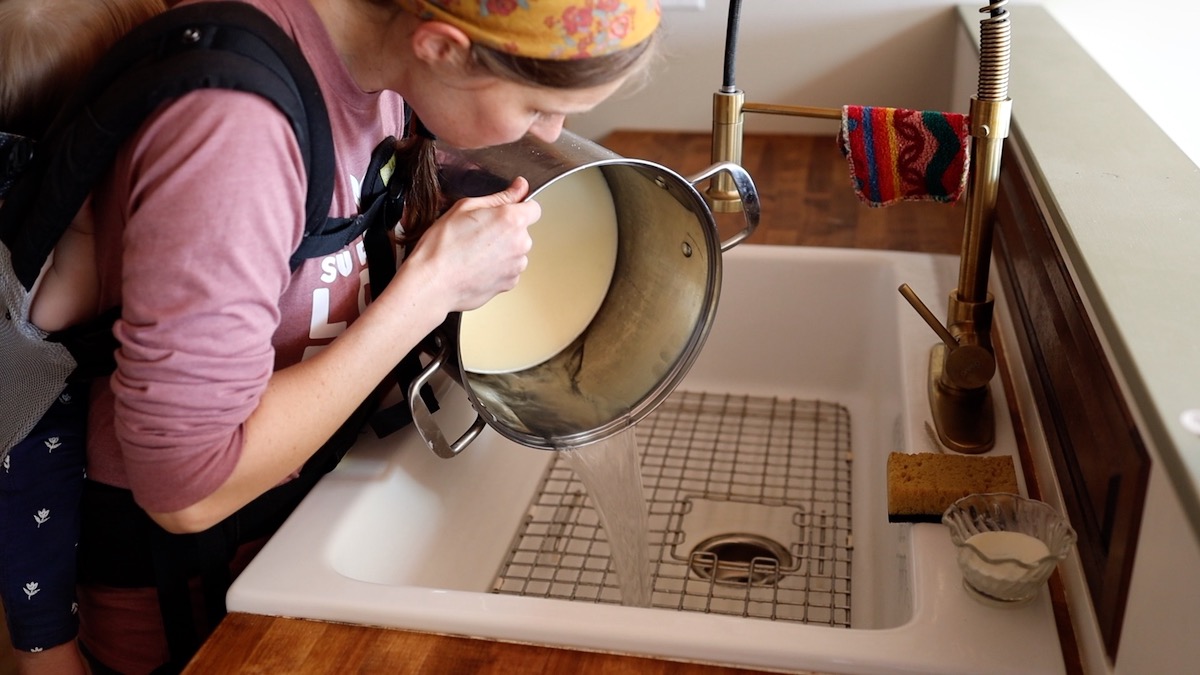
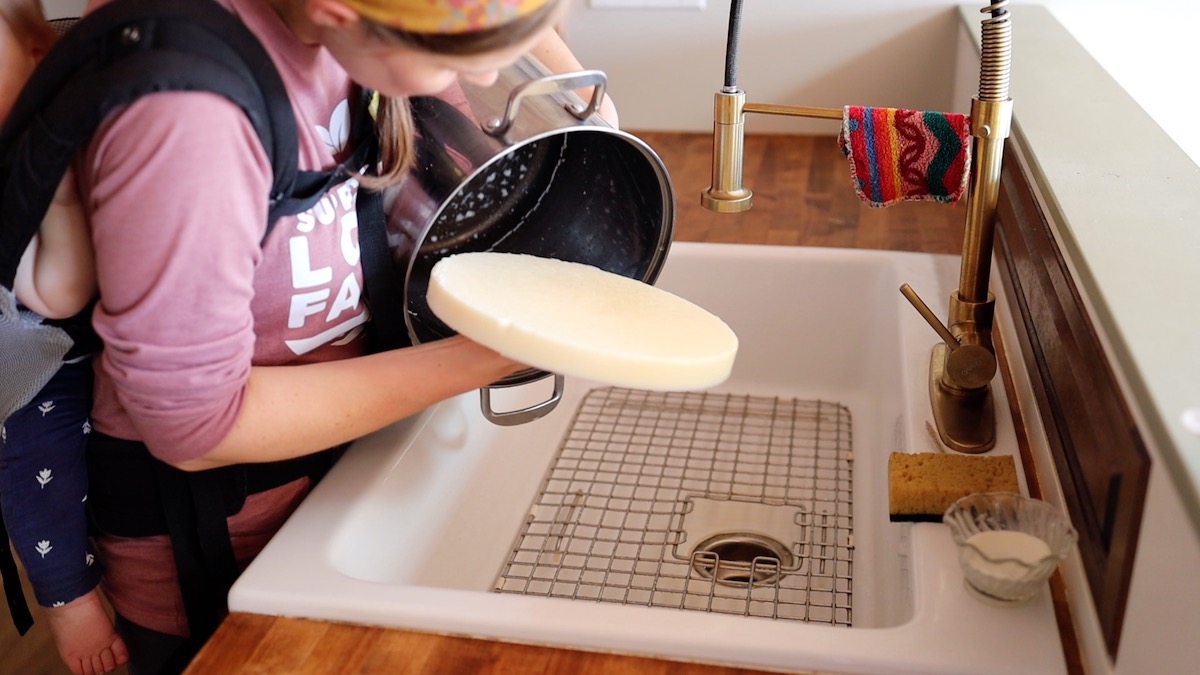
7. Remove the tallow disk and scrape off any grainy impurities until all of the tallow is smooth.
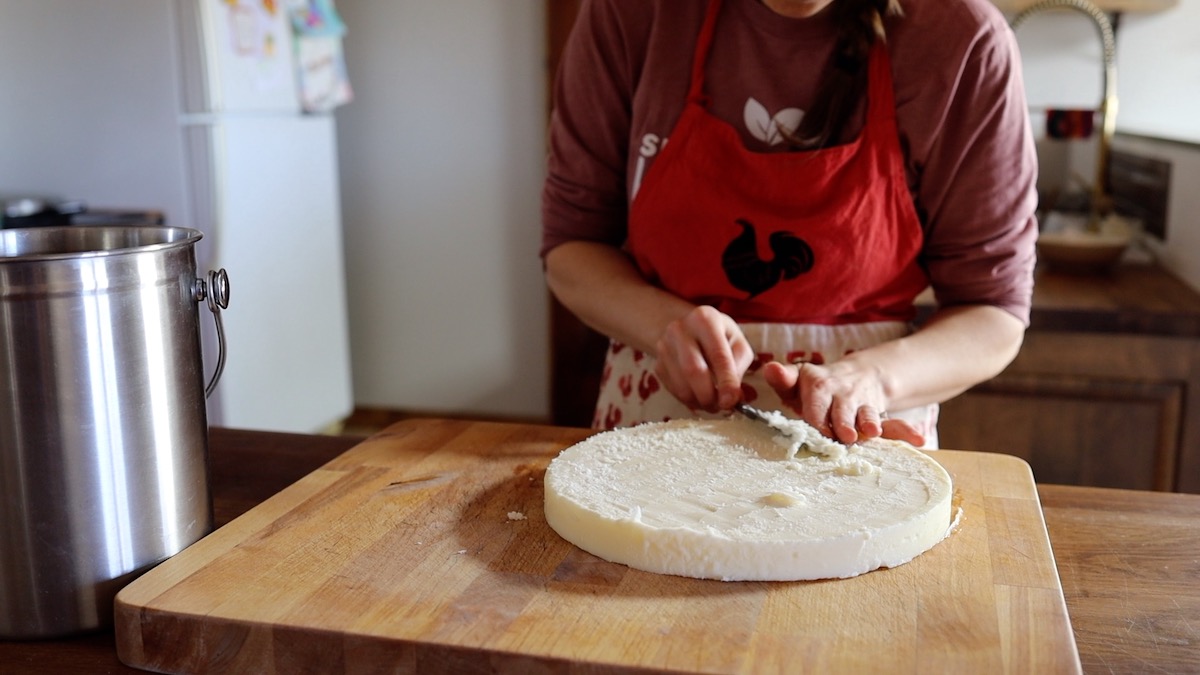
8. Repeat the process as many times as needed until your tallow is completely pure without any grainy texture. We usually find that 2-3 times is sufficient.
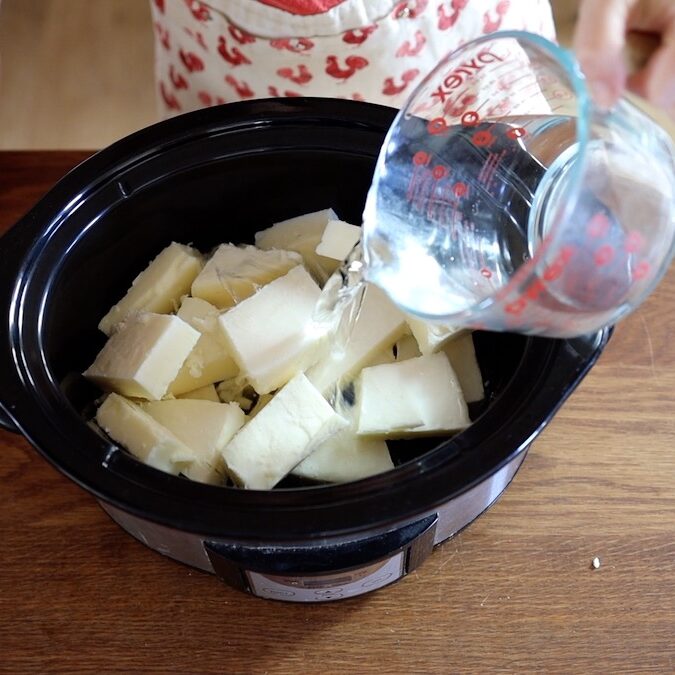
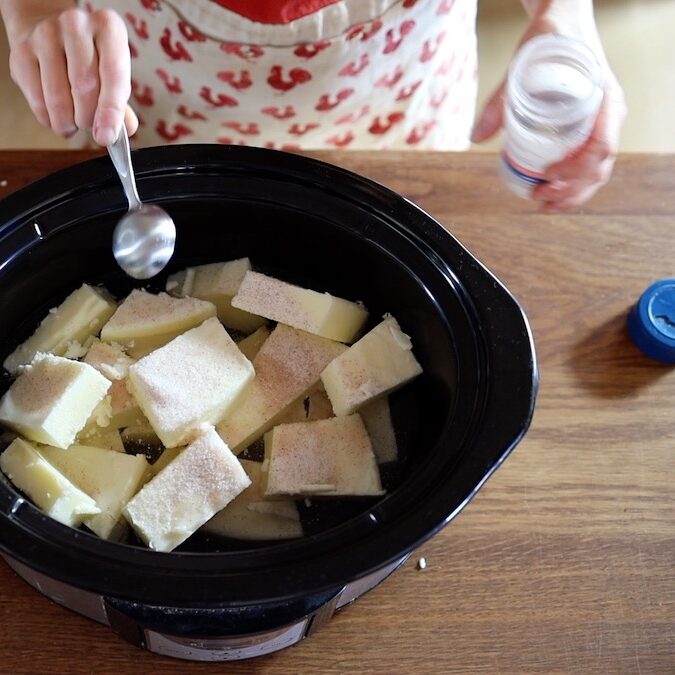
Some of the above links are affiliate links. This means we earn a small commission on qualifying purchases at no cost to you. We are so appreciative of your support!
For our favorite tallow-based skin care recipes, check out:
- Tallow Magnesium Lotion
- Tallow Shampoo Bar
- Tallow Balm
- Tallow Deodorant
- Tallow Sunscreen
- Tallow Drawing Salve
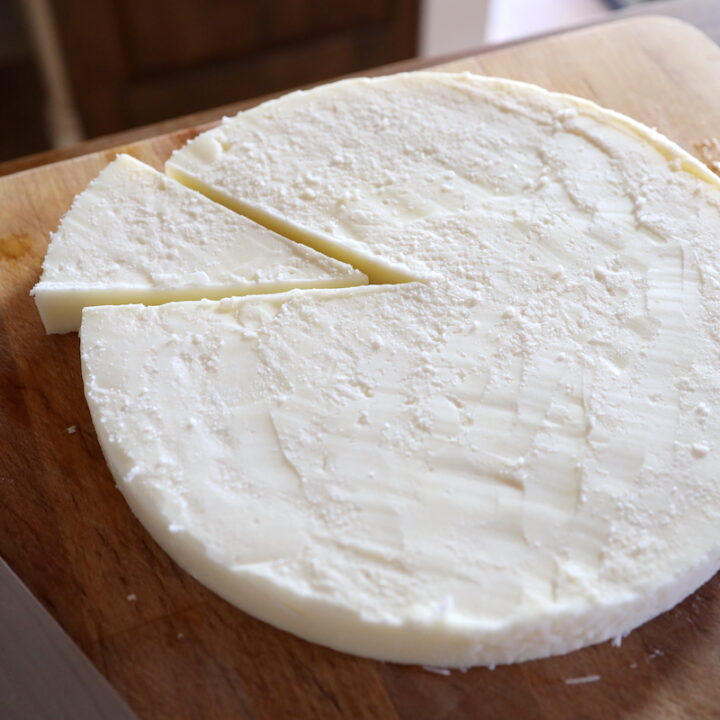
Wet Rendering Tallow for Skincare in a Crock Pot
Interested in making your own tallow-based skincare products? The first step is rendering your tallow so that it is completely purified with no beefy odor. The easiest method that we’ve found to do this is by wet rendering your tallow in a slow cooker. Don’t be intimidated, with this easy to follow, step-by-step guide, you’ll be making your own balms, lotions, and soap in no time!
Ingredients
- Beef suet*, chopped small or shredded
- Sea Salt
- Water
Instructions
- Place suet in a crockpot with roughly 6 cups of filtered water and 3 tbsp salt.
- Cook on low for 6-8 hours, stirring occasionally. Let cool.
- Strain by placing a fine mesh strainer lined with a cheesecloth over a bowl or stock pot. Carefully scoop out the contents of the crockpot and let run through the strainer.
- Gently squeeze out any remaining melted fat from the solid pieces inside the cheesecloth.
- Place bowl in the fridge for 1-2 hours until tallow hardens.
- Remove bowl and scrape along the edges of the tallow to release and pour the separated water in the sink.
- Remove the tallow disk and scrape off any grainy impurities until all of the tallow is smooth.
- Repeat the process as many times as needed until your tallow is completely pure without any grainy texture. We usually find that 2-3 times is sufficient.
Notes
*Note on quantities: I’m not adding specific amounts here because it will depend on how much you want to do/how big your crock pot is and how many times you render. See How To Wet Render Tallow section above for quantities I used as a reference.
Pin it for later!
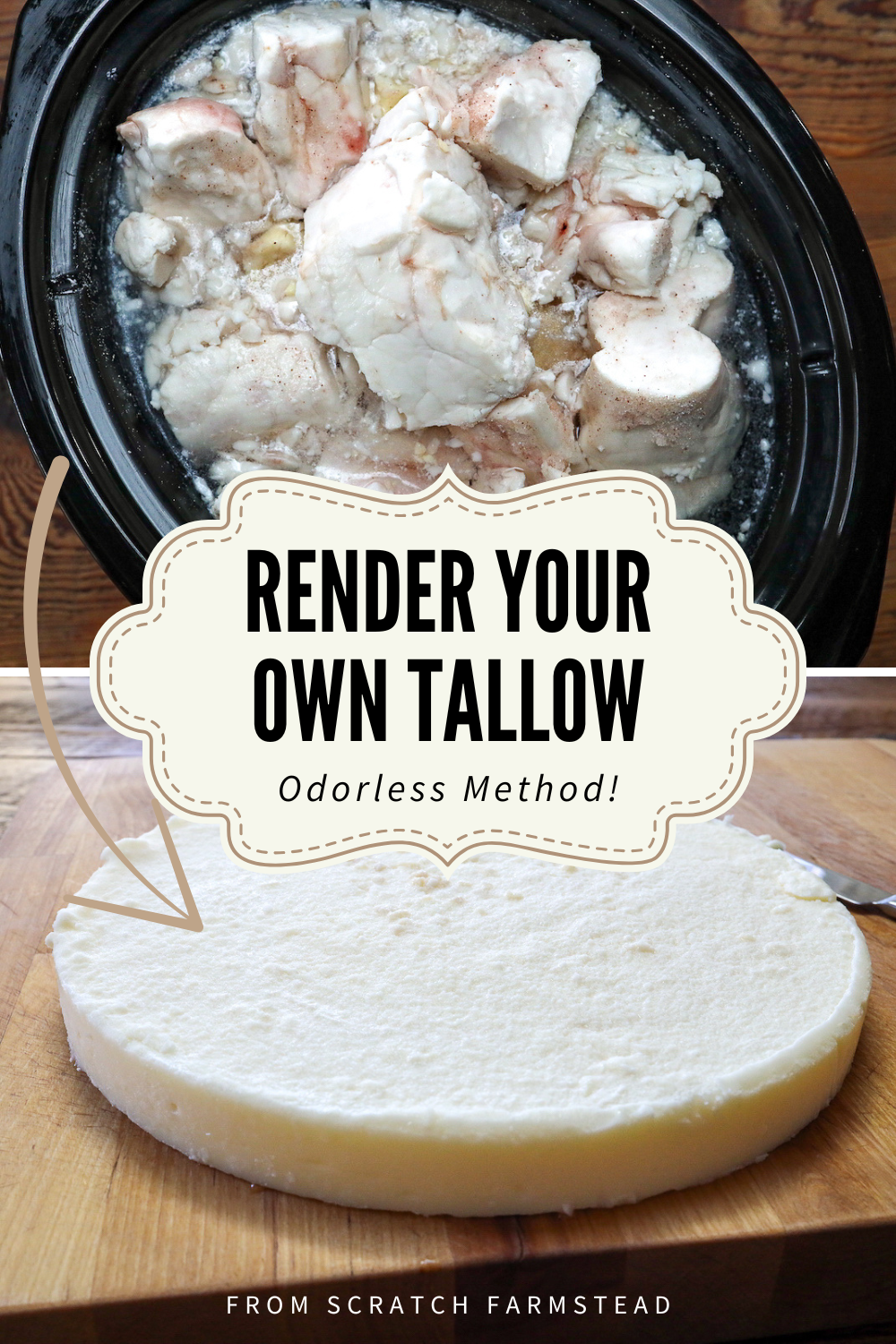

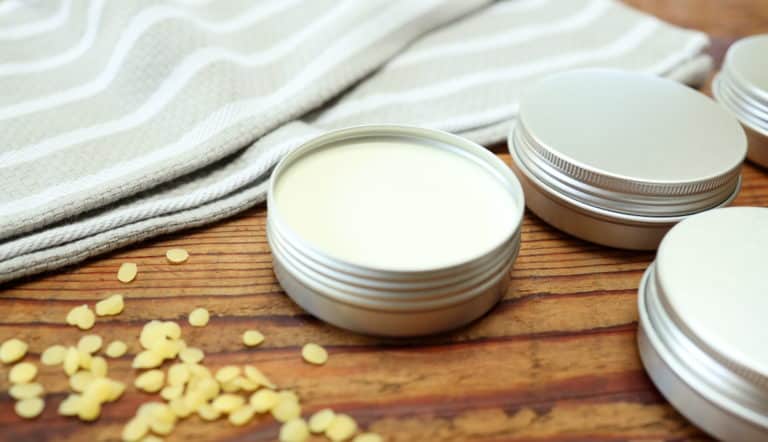
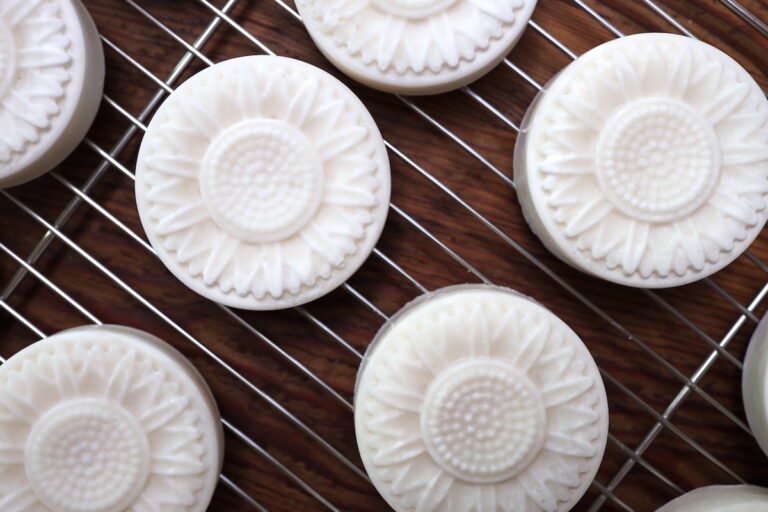
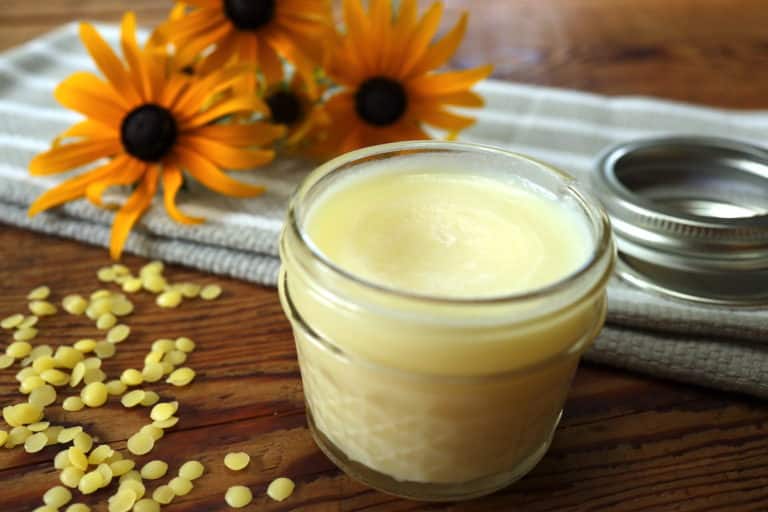


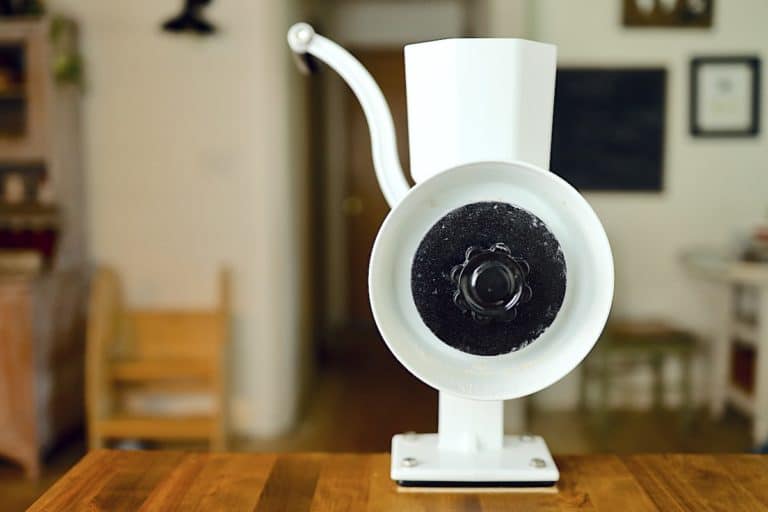
Thank you for sharing this! I just have one question: When you say to repeat the process until it comes out smooth, do you mean repeat the whole process? Like, melt it again overnight with more water and salt?
Hi! Yes, we repeat the whole process again. But with the subsequent times, it’s much easier than the first time and all you need to do is melt the tallow down for a couple of hours. We usually do the process 2-3 times total. The video embedded in the post shows the process too if a visual is helpful!
Thank you so mucho for sharing!
You’re welcome!
I think you are confusing beef fat from suet. They are both fat from cattle, but they are not the same. Suet comes from the area around the kidneys and is usually harder and whiter. Beef fat comes from any area of the cattle, which can include from around the kidneys. Brits use suet when making their mincemeat for mince pies.
Thanks for the comment!
I have repeated the process several times and still smell meat. Does yours have zero odor when complete?
I already have jars of tallow that I rendered using the dry method in my refrigerator. Can I now use those the same way you show with water in a crockpot to get rid of the meaty smell? And then I would be able to use the tallow for skincare products?
Yes! Exactly, melt it down with the water + salt a time or 2 to pull out the odor then use it in skin care products.
If you use a double boiler you don’t have to worry about burning the tallow. Same with lard. I made the most beautiful snowy white lard using a double boiler. It’s really less stressful because the double boiler ensures you aren’t going to burn your fat.
Hello, I have done the process 3 times and the beef smell is still present. Not strong but still present.
Hi Donna! Sometimes the smell doesn’t completely go away unless you keep processing even up to 7 or 8 times. That being said, if you use any essential oils or even other oils, it will cover up any remaining odor. Hope this helps!
If you are using eo and olive oil yo make a lotion…how much would you use per cup of tallow? Also when is it best to whip it?
Hi! This is tallow balm! Here’s the recipe with all of the details 🙂 https://fromscratchfarmstead.com/tallow-balm/
Hi there, if I utilize the wet rendering method, what is the best way to separate the water from the tallow to prevent from spoiling? Also, if I make tallow balm/ moisturizer, what is the shelf life for the product? Thanks so much!
Hi! To ensure the tallow is fully dried, leave it out to dry for a day or two so no more water droplets are there. As long as there is no moisture in the tallow balm, ours has lasted for several months in a cabinet.
I have a two old ceramic insert crockpots. Over 30 years old. Do you know if there’s a concern about lead in these ceramic pot crockpots? Thank you!
Honestly, this isn’t my area of expertise. If you look up lead safe mama, she might have some helpful information!
Hi! Thank you for the recipe! Excited to make your shampoo bar/body soap! I’m done rendering my tallow but water droplets are still forming on top. Am I safe to proceed in making soap… Or do I have to let it set out for a few days to dry completely?
Hi! It should be fine for making soap but if you are planning to store the tallow long term, you’ll want to make sure it’s completely dry so it doesn’t mold. Hope you love this recipe!
Thank you Joelle and Jim for sharing your wealth of knowledge and experience here! I feel excited and empowered to render tallow for my first time. I’m curious if you have any pro tips for how to clean the dishes + cheesecloth without clogging up the pipes with the extra fat. I’m finding it to be a real mess (perhaps because I’m a first time renderer!)
So glad this is helpful! This is a great question and I hear you, this is my least favorite part of the whole process. I try to scrape out what I can to not clog anything and toss in the compost and then just use hot soapy water on the rest. We use a lot of lard and tallow and have for years. So far have never had any issues with clogging our pipes. All the best!
So excited I found your posts
I’m just starting to make tallow but unfortunately can’t get the beef smell out completely after several goes, I have been using pink Himalayan salt instead of sea salt, would that been ok or should I of used sea salt
Thanks again for sharing your recipes
HI! Himalayan salt should work fine. Is it a significantly reduced smell? Sometimes I find that I can’t get the odor 100% gone but it’s so faint that I don’t notice it at all in the skin care products I make, especially if you add a few drops of essential oils. I hope this helps!
Hi! I am on my third try of doing the wet method but have not been able to get the beef smell out. I’ve add distilled water and sea salt to purify. I have done 6 days of purification and it still smells. I currently have it sitting out on my countertop and have noticed water droplets seeping out of the tallow. I thought maybe letting it set out would air out some of the beef smell but no luck. Any ideas why I’m not getting the beef smell out. Any suggestions what I can do? Thank you!
Hi! Is the smell significantly reduced? Sometimes I think there is still a slight odor but it’s so toned down compared to standard beef fat that I don’t notice it when I turn it into skin care products, especially if a few drops of essential oils are added. It sounds like you are doing everything right. Leaving it out to dry is a good idea to dry out all of those little water droplets.
Hi there! I just made tallow for the first time and I am going to give it a second melt to purify it with the salt and water. I didn’t add water the first time so I hope it didn’t burn :/ …now I know!
At what point can I whip and ad EO to it after I’m done washing and purifying it ? I want to make body butter?
Hi there! After you purify it so that the odors of the tallow are eliminated to your liking you can go ahead and use it for whatever skin care products you’d like! I usually do it 2 or 3 times. Others I know do it many more times to completely eliminate any smell. All the best!
Hi, so I did this process but after rendering and Straining the tallow 8 times it still smells like beef. I did the wet render crock pot method overnight with plenty of water every time. A few times it seemed like it was boiling. Do you think that it got too hot and thats why it smells? I had it on low every time
Hi there! Have you noticed the smell going down or does it still smell as “beefy” as when you started. I always find that there’s still a very slight beefy smell but when I turn it into anything for skin care, the smell is really unnoticeable. This is especially true if you add any essential oils or herbs with fragrance. I don’t think it would burn at low with added water.